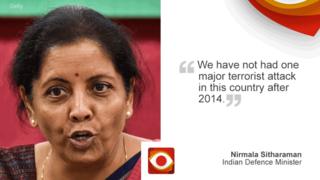No big terror attack under India’s PM?
Claim: India has not experienced a single major terror attack since Prime Minister Narendra Modi’s government came to power in 2014.
Verdict: Both official and independent data provide details of a series of fatal attacks by militant groups within India since 2014. The government’s own documents refer to at least two of these as being “major” attacks.
In a speech to a recent convention of India’s ruling BJP, Defence Minister Nirmala Sitharaman made a bold claim.
“We have not had one major terrorist attack in this country after 2014,” she said.
“There are of course disturbances on the border,” she went on, “but the Indian Army has made sure that every attempt to come into this country is eliminated even at the border.”
The remarks have proved controversial, provoking discussion over what constitutes a “major” attack, given the large number of incidents that have taken place.
Opposition response
“Will the defence minister take the map of India and locate Pathankot and Uri?” tweeted P Chidambaram, former finance minister from the main opposition Congress party.
He was referring to two attacks on military establishments in 2016.
Government figures
The Indian Ministry of Defence breaks down internal security issues into four categories:
According to the government’s own data, presented to parliament by the home affairs ministry, there was a “major terrorist attack in the hinterland” in both 2015 and 2016.
The data presented mentions incidents in the other three categories, but the term “major” is only used with reference to the hinterland.
What is a major attack?
“There’s no policy statement or government release where the difference between a major or minor attack has been defined clearly,” according to defence expert Ajai Shukla.
“It’s a matter of perception,” he says.
“It depends on intangible factors such as the importance of the target, the origin and outcome of the attack and its symbolic value.”
The BBC has sought clarification from the Indian government, pointing out that its own documents refer to “major” terror incidents, but has not received a response at the time of writing this article.
One non-governmental group, the South Asian Terrorism Portal (SATP), provides its own definition of a major attack.
It calls any incident with three or more fatalities – civilian or military – a major attack.
According to SATP, there were 388 “major” incidents in India from 2014 to 2018 using their definition.
Their reporting uses available ministry data and other media reports.
Where has violence risen or fallen?
It’s helpful to look at how insurgent and militant attacks have changed over time, comparing the situation under the current government with that under the previous administration.
From 2009 to 2013, when a Congress-led government was in power, government records show 15 “major cases of terrorist incidents in the hinterland” – significantly more than under the current government.
But incidents in Indian-administered Kashmir, which were showing a steady decline from 2009 to 2014, have been on the rise under the current government.
And in 2018, Indian-controlled Kashmir saw the highest fatalities in terror-related violence in a decade with 451 deaths, according to SATP’s Ajai Sahni.
The last time this toll was exceeded was in 2008 when Congress held power.
In the north-eastern part of the country, except for a spike in 2012, there have been fewer and fewer reports of violent incidents – and a sharp fall in civilian deaths since 2015, according to official data.
The region has seen ethnic and separatist conflicts for decades, involving a variety of groups fighting for local autonomy or complete independence.
When it comes to left-wing insurgent groups in the country, Prime Minister Narendra Modi has compared his government’s track record favourably to the previous Congress-led administration.
Mr Modi told the Swarajya magazine in July 2018: “Maoist violence has declined by 20% in the affected states with a concomitant reduction of 34% in deaths in 2017 compared to 2013.”
Maoist rebels, who are active in several eastern and central states, say they are fighting for communist rule and greater rights for tribal people and the rural poor.
Mr Modi’s figures about the decrease in fatalities match the official tally.
But according to the Home Affairs Ministry’s own reports, the declining trend in this type of insurgency actually began in 2011 under the previous government.
Read more from Reality Check
Send us your questions
Follow us on Twitter
Source: Read Full Article



